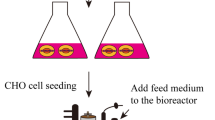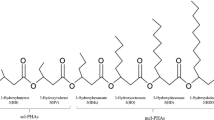Abstract
A high cell density culture system for the anchorage dependent CHO cells was developed based on the combination ofin situ removal of ammonium ion and microcarrier culture system, and semi-fed-batch feeding of glucose and glutamine was employed to the developed culture system. The glass bead was selected as an optimum microcarrier in terms of cell growth. An ammonium ion selective zeolite, Phillipsite-Gismondine, was packed in a dialysis membrane and equipped on the agitator of spinner reactor forin situ removal of ammonium ion. The semi-fed-batch operation was employed to the novel culture system for the high density cell culture, and the results showed the cell growth was improved by 32% and tPA productivity by 250%.
Similar content being viewed by others
References
Rijken, D. C., M. Hoylaerts, and D. Collen (1982) Fibrinolytic properties of one-chain and two-chain human extrinsic (tissue-type) plasminogen activator.J. Biol. Chem. 257: 2920–2925.
Hoylaerts, M., D. C. Rijken, H. R. Lijnen, and D. Collen (1982) Kinetics of the activation of plasminogen by human tissue plasminogen activator.J. Biol. Chem. 257: 2912–2919.
Nieuwenhuizen, W., J. H. Verheijen, A. Vermond, and C. T. G. Chang (1983) Plasminogen activation by tissue activator is accelerated in the presence of fibrinogen cyanogen bromide fragment FCB-2.Biochem. Biophys. Acta 755: 531–533.
Ranby, M. (1982) Studies on the kinetics of plasminogen activation by tissue plasminogen activator.Biochem. Biophys. Acta 704: 461–469.
Eagle, H. (1955) The specific amino acid requirements of a mammalian cell in tissue culture.J. Biol. Chem. 114: 839–858.
Telling, R. C., and P. J. Radlett (1970) Large-scale cultivation of mammalian cells.Adv. Appl. Microbiol. 13: 91–119.
Batt, B. C. and D. S. Kompala (1989) A structured kinetic modeling framework for the dynamics of hybridoma growth and monoclonal antibody production in continuous suspension culture.Biotechnol. Bioeng. 34: 515–531.
Butler, M., and R. E. Spier (1984) The effects of glutamine utilization and ammonia production on the growth of BHK cells in microcarrier cultures.J. Biotechnol. 1: 187–196.
Zielke, H. R., C. L. Zielke, and P. T. Ozand (1984) Glutamine a major energy source for cultured mammalian cells.Fed. Proc. 43: 121–125.
Raivio, K. O., and J. E. Seegmiller (1973) Role of glutamine in purine synthesis and in guanine nucleotide formation in normal fibroblasts and in fibroblasts deficient in hypoxanthine phosphoribosyl-transferase activity.Biochem. Biophys. Acta 299: 283–292.
Glacken, M. W. (1988) Catabolic control of mammalian cell culture.Bio/Technology 6: 1041–1050.
Ryan, W. L., and C. Cardin (1966) Amino acids and ammonia of fetal calf serum during storage.Proc. Soc. Exp. Biol. Med. 123: 27–30.
Visek, W. J., G. M. Kolodny, and P. R. Gross (1972) Ammonia effects in cultures of normal and transformed 3T3 cells.J. Cell Physiol. 80: 373–382.
Reuveny, S., D. Velez, J. D. Macmillan, and L. Miller (1986) Factors affecting cell growth and monoclonal antibody in stirred reactors.J. Immunol. Meth. 86: 53–59.
Glacken, M. W., R. J. Fleischaker, and A. J. Sinskey (1986) Reduction of waste product excretion via nutrient control: possible strategies for maximizing product and cell yields on serum in cultures of mammalian cells.Biotechnol. Bioeng. 28: 1376–1389.
Miller, W. M., C. R. Wilke, and H. W. Blanch (1988) Transient responses of hybridoma cells to lactate and ammonia pulse and step changes in continuous culture.Bioproc. Eng. 3: 113–122.
Jensen, E. M., and O. C. Liu (1961) Studies of inhibitory effects of ammonium ions in several virus-tissue culture systems.Proc. Soc. Exp. Biol. Med. 107: 834–838.
Eaton, M. D., and A. R. Scala (1962) Inhibitory effect of glutamine and ammonia on replication of influenza virus in ascites tumor cells.Virology 13: 300–307.
Furusawa, E., and W. Cutting (1962) Inhibitory effect of ammonia sulfate on Columbian SK virus propagation in mouse ascites tumor cellsin vitro.Proc. Soc. Exp. Biol. Med. 111: 71–75.
Glacken, M. W., R. J. Fleischaker, and A. J. Sinskey (1986) Reduction of waste product excretion via nutrient control: possible strategies for maximizing product and cell yields on serum in cultures of mammalian cells.Biotechnol. Bioeng. 28: 1376–1389.
Griffiths, J. B. (1973) The effects of adapting human diploid cells to grow in glutamic acid media on cell morphology, growth and metabolism.J. Cell. Sci. 12: 617–629.
Hosoi, S., H. Mioh, C. Anzai, S. Sato, and N. Fujiyoshi (1988) Establishment of Namalva cell lines which grow continuously in glutamine-free medium.Cytotechnology 1: 151–158.
Hassell, T. E., I. C. Allen, A. J. Rowley, and M. Butler (1987) The use of glutamine-free media for the growth of three cell lines in microcarrier culture, pp. 245–263 In: R. E. Spier and J. B. Griffiths (eds.)Modern Approaches to Animal Cell Technology, Butterworths, London.
Bebbington, C. R., G. Renner, S. Thomson, D. King, D. Abrams, and G. T. Yarranton (1992) High-level expression of a recombinant antibody from myeloma cells using a glutamine synthetase gene as an amplifiable selectable marker.Bio/Technology 10: 169–175.
Schumpp, B., and E. J. Schlaeger (1992) Growth study of lactate and ammonia double-resistant clones of HL-60 cells. pp. 183–185. In: R. E. Spier, J. B. Griffiths, and J. B. Macdonalds (eds.)Animal cell technology: Developments, process & products, Butteworth-Heinemann, Oxford, UK.
Iio M., A. Moriyama, and H. Murakami (1985) Effects on cell proliferation of metabolites produced by cultured cells and their removal from culture in defined media pp. 437–442. In: H. Murakami, I. Yamane, D. W. Barnes, J. P. Mather, I. Hayashi, and G. H. Sato (eds.)Growth and Differentiation of Cells in Defined Environment. Springer-Verlag, Berlin.
Jeong, Y. H. and S. S. Wang (1992)In situ removal of ammonium ions from hybridoma cell culture media: selection of adsorbent.Biotechnol. Tech. 6: 341–346.
Jeong, Y. H., H. I. Lee, G. T. Chun, I. H. Kim, and S. S. Wang (1996) Ammonium ion effects and its in situ removal by using immobilized adsorbent in hybridoma cell cultureKon.J. Biotechnol. Bioeng. 11: 329–339.
Kim, I. H., Y. H. Jeong, G. T. Chun, and S. S. Wang (1997) Increase of hybridoma cell density and monoclonal antibody productivity by in situ removal of ammonium ion with immobilized adsorbent beads. In: K. Funatsuet al. (eds.)Animal Cell Technology: Basic & Applied Aspects 8: 237–247.
Park, B. G., Y. W. Min, G. T. Chun, I. H. Kim, and Y. H. Jeong (1998) Development of an immobilized adsorbent for in situ removal of ammonium ion from mammalian cell culture media and its application to a mammalian cell bioreactor: Development of immobilized adsorbent system.Korean J. Biotechnol. Bioeng. 13: 404–410.
Park, B. G., H. I. Rhee, G. T. Chun, I. H. Kim, and Y. H. Jeong (1998) Development of an immobilized adsorbent for in situ removal of ammonium ion from mammalian cell culture media and its application to a mammalian cell bioreactor: Application to cell culture system.Korean J. Biotechnol. Bioeng. 13: 411–417.
Matsumura, M. and F. R. P. Nayve (1995) Effect of amhybridoma cells.Cytotechnology 18: 35–50.
Chang, Y. H. D., A. J. Grodzinsky, and D. I. C. Wang (1995)In-situ removal of ammonium and lactate through electrical means for hybridoma cultures.Biotechnol. Bioeng. 47: 308–318.
Ozturk, S. S., M. E. Meyerhoff, and B. O. Palsson (1989) Measurement of ammonia and glutamine in cell culture media by gas sensing electrodes.Biotechnol. Tech. 3: 217–222.
Zaoui, D., B. L. Fevre, H. Magdelenat, and J. G. Bieth (1984) A simple spectrophotometric assay of plasminogen activator: comparison with the fibrinolytic method.Chil. Chem. Acta 141: 101–109.
McQueen A., and J. E. Bailey (1990) Growth inhibition of hybridoma cells by ammonium ion: correlation with effects on intracellular pH.Bioproc. Eng. 6: 49–61.
Ryll, T., U. Valley, and R. Wagner (1994) Biochemistry of growth inhibition by ammonium ions in mamalian cells.Biotechnol. Bioeng. 44: 184–193.
Jeong, Y. H., and S. S. Wang (1995) Role of glutamine in hybridoma cell culture: Effect on cell growth, antibody production and cell metabolism.Enzyme Microb. Technol. 17: 47–55.
Author information
Authors and Affiliations
Corresponding author
Rights and permissions
About this article
Cite this article
Park, BG., Chun, JM., Lee, CJ. et al. Development of high density mammalian cell culture system for the production of tissue-type plasminogen activator. Biotechnol. Bioprocess Eng. 5, 123–129 (2000). https://doi.org/10.1007/BF02931883
Received:
Accepted:
Issue Date:
DOI: https://doi.org/10.1007/BF02931883




